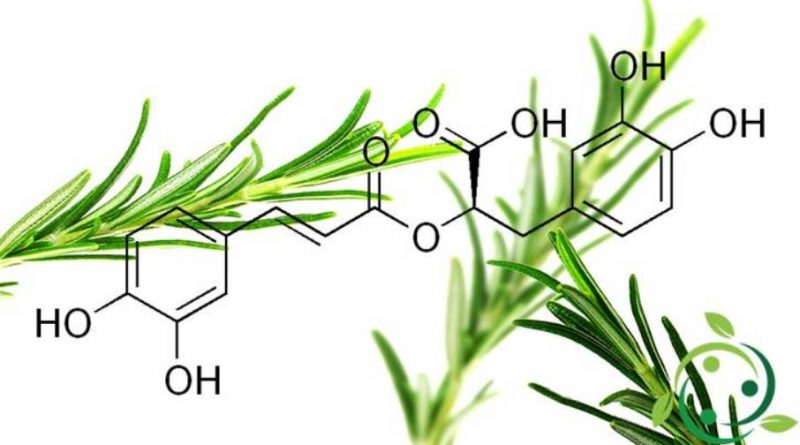Rosmarinic acid
Rosmarinic acid
Rosmarinic acid, whose name in the IUPAC nomenclature is: acid 3- (3,4-dihydroxyphenyl) -2R – {[3- (3,4-dihydroxyphenyl) prop-2E-enoyl] oxy} propanoic and whose formula brute or molecular is: C18H16O8, is a polyphenolic acid found in many plants belonging to the Lamiaceae family such as rosemary, sage, marjoram, oregano, thyme, peppermint and lemon balm.
From the chemical point of view it is an ester between caffeic acid and the alcoholic group in the α position of 3,4-dihydroxyphenyl acid. It is a substance slightly soluble in water but very soluble in apolar solvents.
Rosmarinic acid, in addition to its anti-radical properties, shows antimicrobial and antifungal properties. It is a substance known and used in various parts of the world and in various cultures.
Rosmarinic acid contained in Ocimum santctum (holy basil) is widely used in India to treat wounds and gastrointestinal diseases. In Mexico the high content of rosmarinic acid present in another spica: Hyptis verticillata, is used by the Mixtec Indians against gastrointestinal disorders and skin infections.
In Indonesia and in many other parts of south-eastern Asia, rosmarinic acid contained in Orthosiphon aristatus is known for its diuretic properties and is also used against bacterial infections and inflammation of the urinary system. Furthermore the high content of rosmarinic acid in Salvia cavaleriei is used for the treatment of dysentery, burns and wounds.
The most important research on the activity of rosmarinic acid confirms that it is the caffeolic ester with the highest specific antioxidant power: it delays the impoverishment (deficiency) of vitamin E and decreases the pro-inflammatory production of lysophosphatidylcholine.
Rosmarinic acid prevents the oxidation of LDL and its constituents (vitamin E, phosphatidylcholine), which is compatible with the anti-inflammatory and anti-atherosclerotic role in pathophysiological conditions. Recently it has been reported that rosmarinic acid has antimicrobial and antifungal properties against 40 different species belonging to 10 genera of bacteria and 25 different strains belonging to 25 species of fungi (Andary and Audre, 1998).
The bacterial species that have been studied are: Salmonella, Serratia, Enterobacter, Proteus, Providentia, Escherichia coli, Streptococcus, Klebsiella and Staphylococci. In all the bacteria a 100% inhibition was observed at a dose of 0.5 mg / ml. Detailed studies on 29 Staphylococcus aureus strains showed a 70% inhibition at the concentration of 0.06 mg / ml and an inhibition of 80% at 0.12 mg / ml (Andary and Audre, 1998); in addition, an antifungal activity was tested against the species: Adelomycetes; Mucorales, Rhizopus, Endomycetes, Plectomycetes and Pyrenomycetes (Andary and Audre, 1998).
Warning: The information given is not medical advice and may not be accurate. The contents are for illustrative purposes only and do not replace medical advice.

